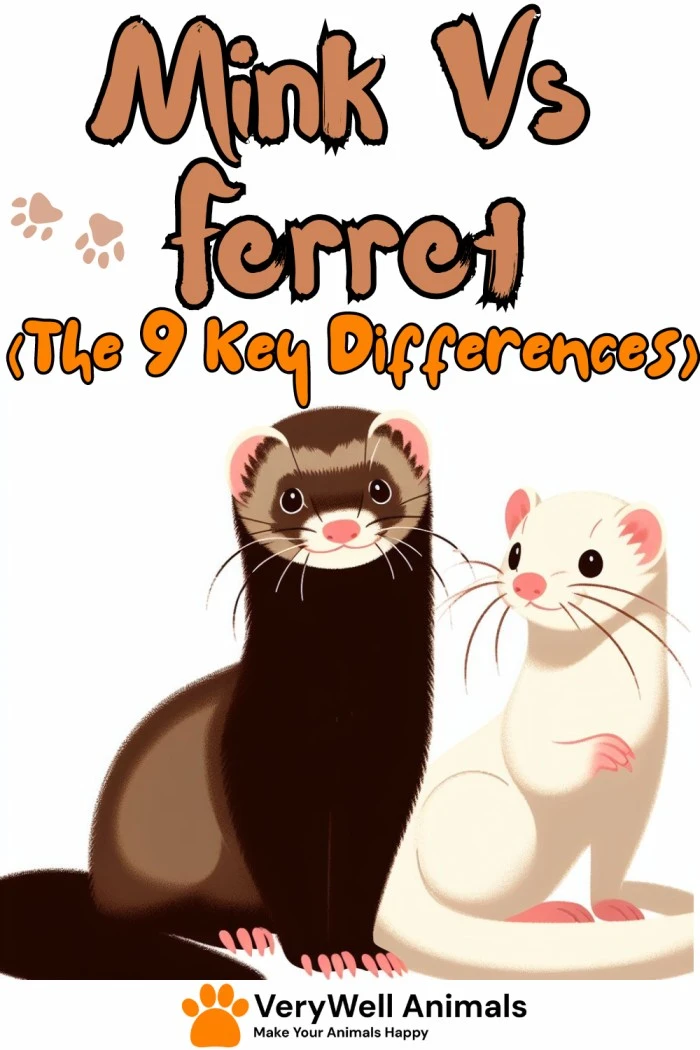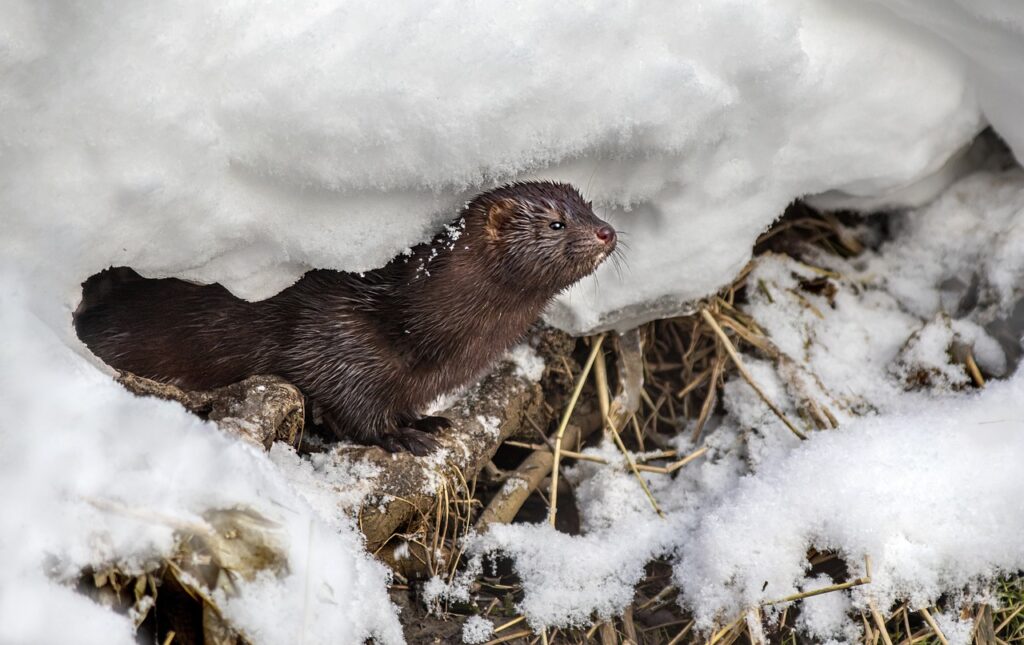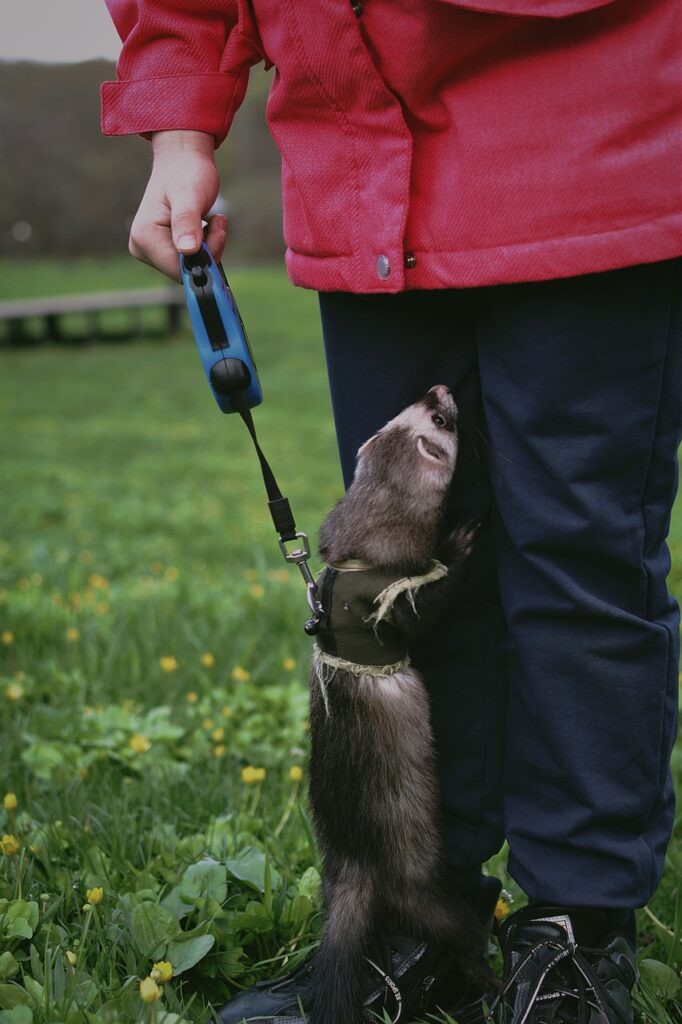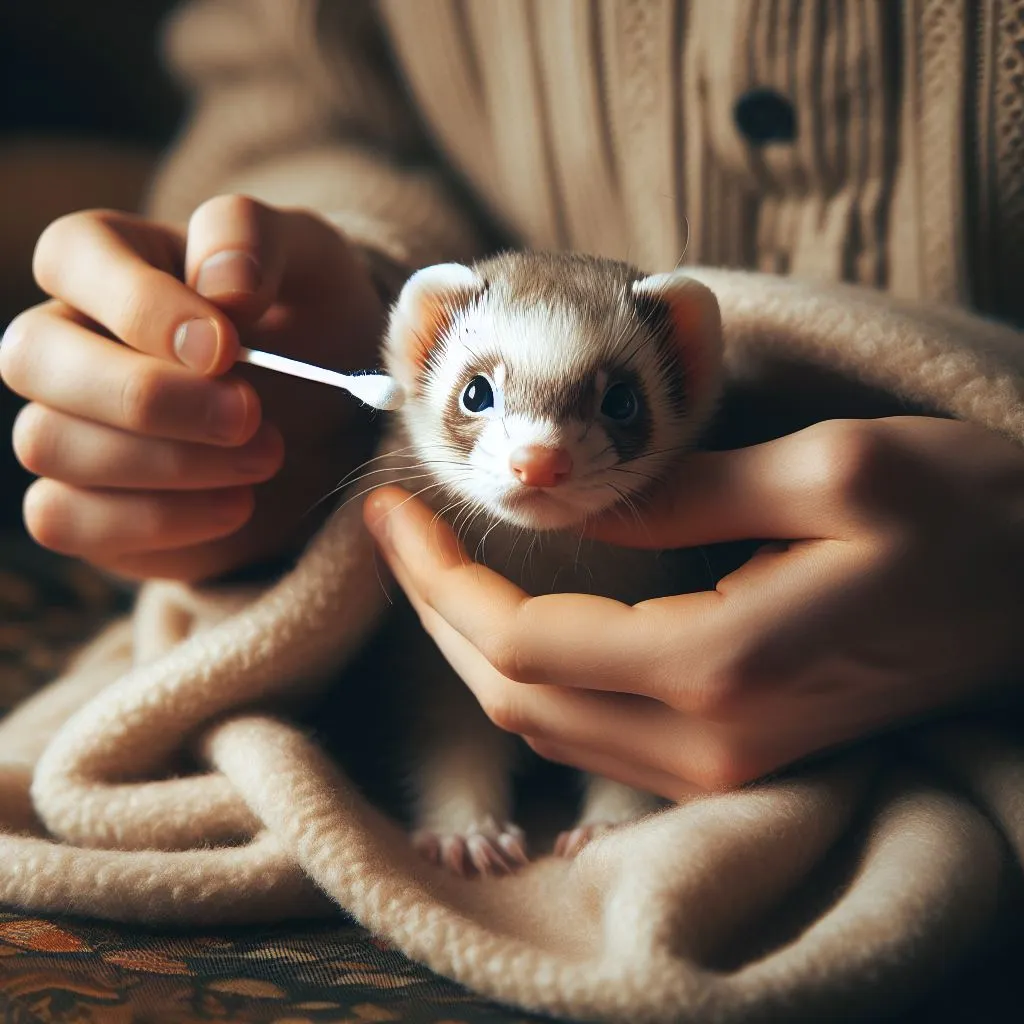Mink vs Ferret | The 8 Key Differences

This blog post is about minks and ferrets. They are both animals in the Mustelidae family, but they have different looks and behaviors. We will talk about how they can be domesticated and their impact.
By learning about these things, you can decide which one would be a good pet or friend. Let’s learn about minks and ferrets and what makes them special.
Key Differences Between Mink And Ferret
| Criteria | Minks | Ferrets |
|---|---|---|
| Taxonomy and Classification | Neovison vison (Minks) | Mustela putorius furo (Ferrets) |
| Physical Characteristics | Larger, 20-28 inches long | Smaller, 13-18 inches long |
| Behavioral Traits | Solitary, excellent swimmers | Social, playful, terrestrial |
| Habitats | Aquatic environments, rivers, lakes | Varied, grasslands, forests |
| Domestication | Less common as pets, wild instincts | Common pets, domesticated for centuries |
| Ecosystem Role | Control prey populations, maintain biodiversity | Control prey populations, prevent overpopulation |
| Care and Nutrition | Specialized diet, high-quality fish and meat | High protein diet, limited carbohydrates |
| Legal Considerations | Ownership may be restricted, potential impact on ecosystems | Generally legal, regulations on breeding and welfare |
Related: Weasels Vs Ferrets | The 9 Key Differences Among Them
Topics Covered In This Article
- Key Differences Between Mink And Ferret
- Taxonomy and Classification of Mink vs Ferret
- Physical Characteristics: Mink vs Ferret
- Behavioral Traits of Minks and Ferrets
- Habitats: Where Minks and Ferrets Thrive
- Minks and Ferrets in Domestication
- The Role of Minks and Ferrets in Ecosystems
- Care and Nutrition for Pet Minks and Ferrets
- Legal and Ethical Considerations in Keeping Minks and Ferrets
- Closing Thoughts
- Frequently Asked Questions
Taxonomy and Classification of Mink vs Ferret
Genetic Differences Reflected in Taxonomy
Minks and ferrets are both members of the Mustelidae family, but they belong to different families within this group. Minks are classified as Neovison vison, while ferrets are classified as Mustela putorius furo. These classifications reflect the genetic differences between minks and ferrets.
Distinct Families Within Mustelidae Family
The Mustelidae family is a diverse group that includes various carnivorous mammals. While minks belong to the family Mustelidae, they specifically fall under the subfamily called “Mustelinae.” On the other hand, ferrets belong to a different subfamily known as “Mustelinae.”
Different Species with Unique Characteristics
Although minks and ferrets share some similarities due to their common ancestry, they have distinct characteristics that set them apart from each other. For example, minks have sleek bodies with thick fur that comes in various colors such as brown or black. They also possess webbed feet which make them excellent swimmers.
Ferrets, on the other hand, have long slender bodies with short legs and small ears. Their fur is usually light brown or cream-colored with darker markings around their face and body. Unlike minks, ferrets do not possess webbed feet but instead have sharp claws for digging.
Physical Characteristics: Mink vs Ferret
Size and Body Shape

Minks and ferrets have distinct differences in their physical characteristics.Minks are generally larger than ferrets. On average, minks measure around 20-28 inches in length.

While ferrets have a more slender body shape, measuring approximately 13-18 inches long. This means that minks are typically longer than ferrets.
Build and Tail Length
Another noticeable difference between minks and ferrets is their body build. Minks have a more muscular build compared to the slender physique of ferrets. Their bodies are well-adapted for swimming and hunting aquatic prey such as fish or amphibians.
In addition to their body build, the length of their tails also sets them apart. Minks possess longer tails when compared to the relatively shorter tails of ferrets. The tail of a mink serves various purposes, including acting as a rudder during swimming or providing balance while climbing trees.
These differences in size, body shape, muscularity, and tail length contribute to each animal’s unique appearance and physical abilities.
To summarize:
- Minks are larger than ferrets.
- Ferrets have a slender body shape.
- Minks have a more muscular build.
- Minks possess longer tails compared to ferrets.
Behavioral Traits of Minks and Ferrets
Aquatic vs Terrestrial
Minks and ferrets have different preferences. Minks are semi-aquatic animals, which means they feel right at home in the water. They are excellent swimmers and can easily navigate through rivers, streams, and marshes. On the other hand, ferrets are primarily terrestrial creatures. They prefer dry land and don’t have the same affinity for water as minks do.
Solitary vs Social
Another significant difference between minks and ferrets lies in their social behavior. Minks tend to be solitary animals that prefer to live alone. They establish territories for themselves where they hunt for food and raise their young ones without much interaction with others of their kind.
In contrast, ferrets are highly social creatures that thrive in groups. They enjoy the company of fellow ferrets and engage in playful interactions with them. Their curious nature often leads them on exploratory adventures together, making them a joy to watch as they frolic around.
While minks may only tolerate brief encounters with other members of their species during mating season or territorial disputes, ferrets actively seek out companionship throughout their lives.
These behavioral differences reflect how these two animals have adapted to survive in different environments: mink’s solitary lifestyle allows it to focus on hunting efficiently while avoiding competition from others; while ferret’s group living provides protection against predators through collective vigilance.
Habitats: Where Minks and Ferrets Thrive
Minks’ Aquatic Environments
Minks are well-suited to live in various aquatic environments such as rivers, lakes, and wetlands. These small mammals have adapted to life in the water and can be found swimming gracefully in search of food.
They have sleek bodies, webbed feet, and dense fur that helps them stay warm even in cold water. Minks are excellent swimmers and can dive underwater for several minutes at a time.
In their natural habitats, minks build dens along riverbanks or under tree roots near the water’s edge. These dens provide shelter from predators and serve as safe spaces for raising their young. By living close to the water, minks have easy access to their primary source of food – fish! They also feed on other aquatic creatures like frogs, crayfish, and small mammals.
Ferrets’ Burrowing Lifestyle
On the other hand, ferrets thrive in different types of habitats that offer suitable conditions for burrowing. Grasslands, forests, agricultural areas – these are some places where you might find these curious creatures exploring underground tunnels they dig themselves or take over from other animals.
Ferrets are agile climbers too; they can scale trees with ease when needed. However, it is within their cozy burrows where they feel most at home. These burrows provide protection from harsh weather conditions as well as safety from potential predators.
While ferrets do not require direct access to water like minks do since they obtain moisture through their diet alone (such as by consuming juicy insects), they still prefer areas near freshwater sources such as streams or ponds for drinking purposes.
Minks and Ferrets in Domestication
Domesticated Ferrets as Pets
Ferrets have been domesticated for thousands of years and are commonly kept as pets by people all around the world. These adorable animals belong to the mustelid family, which includes other species like otters and weasels. Unlike their wild counterparts, domesticated ferrets come in a variety of coat colors and patterns, making them even more appealing to pet owners.
Domesticated ferrets have unique characteristics that make them suitable companions for humans. They are playful, curious, and highly social creatures that enjoy interacting with their owners. Their mischievous nature often brings laughter and joy to households where they reside.
One interesting fact about ferrets is their ability to adapt well to living indoors. They can be litter trained just like cats and can spend most of their time roaming freely within a safe environment. However, it’s important for ferret owners to provide plenty of mental stimulation through toys, tunnels, and interactive playtime sessions.
Related Read: The 3 Best Ferret Cages Of 2024 | Tested & Reviewed By Experts
Minks: Less Commonly Kept as Pets
While minks can also be bred in captivity like ferrets, they are less commonly kept as pets due to their specific needs. Minks are semi-aquatic mammals known for their sleek fur coats that were historically prized in the fur trade industry.
Mink behavior differs from that of domesticated ferrets because they retain many instinctual traits from their wild ancestors. In the wild, minks are skilled hunters that primarily prey on small animals such as rabbits and rats near bodies of water. They use burrows or tunnels dug into riverbanks or marshes as shelter.
Due to these natural instincts and behaviors retained by minks even when bred in captivity, providing an appropriate environment for them can be challenging for most people looking for a pet companion.
The Role of Minks and Ferrets in Ecosystems
Controlling Prey Populations
Minks and ferrets are both important predators in their respective ecosystems. They play a crucial role in maintaining the balance of these habitats by controlling the populations of certain prey animals.
Minks, for example, are skilled hunters that primarily feed on rodents, fish, and amphibians. They have sharp teeth and strong jaws that allow them to catch and consume their prey efficiently. By keeping the populations of these animals in check, minks help prevent overpopulation which can lead to negative consequences such as habitat destruction or disease outbreaks.
Similarly, ferrets also contribute to ecosystem balance by regulating prey populations. These small mammals are known for their excellent hunting skills and often target small mammals like rabbits and rodents. By preying on these animals, ferrets help control their numbers and prevent them from overwhelming the ecosystem.
Maintaining Biodiversity
In addition to controlling prey populations, minks and ferrets also play a role in maintaining biodiversity within their habitats. When one species becomes too dominant due to lack of predation pressure, it can disrupt the delicate balance of an ecosystem.
By regulating prey populations through predation, minks ensure that different species have access to resources such as food and shelter. This allows for a more diverse range of plants and animals within an ecosystem.
Ferrets also contribute to biodiversity by preventing any single species from becoming too abundant. Their hunting activities help maintain a healthy mix of different organisms within their environment.
Care and Nutrition for Pet Minks and Ferrets
Specialized Diets for Minks and Ferrets
Minks are unique creatures that require a specialized diet to meet their nutritional needs. Their diet should consist of high-quality fish, meat, and supplements.
These components provide the essential nutrients minks need to stay healthy. By feeding them a balanced diet, owners can ensure that their pet mink receives the proper nutrition it requires.
On the other hand, ferrets also have specific dietary requirements. They thrive on a high protein diet with limited carbohydrates. This means that they need food rich in animal-based proteins such as chicken or turkey. It’s important to avoid feeding them foods high in sugar or fiber as these can upset their delicate digestive system.
The Importance of Regular Check-ups and Appropriate Housing
Both pet minks and ferrets require regular veterinary check-ups to maintain their well-being. During these visits, veterinarians can examine them thoroughly, ensuring they are free from any health issues or diseases. Vaccinations are also crucial for both species to protect against common illnesses.
In addition to medical care, providing appropriate housing is vital for the happiness of your pet mink or ferret. Minks should be housed in spacious enclosures that mimic their natural habitat with plenty of room for exercise and exploration. Similarly, ferrets need ample space within their cages along with various toys and tunnels to keep them mentally stimulated.
Legal and Ethical Considerations in Keeping Minks and Ferrets
Regulations on Pet Ownership
It’s important to note that their ownership may be regulated or even prohibited in certain regions. This is due to concerns about the potential impact they can have on native wildlife. Some countries or states have recognized the risk of introducing non-native species into the environment, which can disrupt local ecosystems.
Therefore, before considering a mink as a pet, it is crucial for potential owners to research and understand the laws and regulations specific to their area.
On the other hand, ferret ownership is generally legal in many countries. However, there are often specific regulations regarding breeding, transportation, and welfare that need to be followed. These regulations aim to ensure responsible pet ownership and prevent any harm or mistreatment towards these animals.
Researching Local Laws and Ethical Considerations
Before acquiring either a mink or ferret as a pet, it is essential for prospective owners to thoroughly research local laws related to their ownership. This includes understanding whether owning minks is allowed at all in their area or if there are any restrictions placed upon them.
Ethical considerations should also play a significant role when deciding whether to keep these animals as pets. It’s important for individuals considering owning either of these creatures to think about how they will provide proper care for them throughout their lives.
They should consider factors such as space requirements, appropriate diet plans, socialization needs with humans and other animals (if applicable), veterinary care availability nearby etc.
Related Read: Stoat vs Ferret | The 9 Key Differences
Closing Thoughts
In conclusion, the comparison between minks and ferrets reveals fascinating insights into their taxonomy, physical characteristics, behavioral traits, habitats, domestication, ecological roles, care and nutrition, as well as legal and ethical considerations.
Understanding these aspects is crucial for anyone interested in these animals, whether as pets or for scientific study. Minks and ferrets may share similarities in appearance and behavior, but they also possess distinct features that set them apart.
With their sleek bodies and sharp hunting skills, minks are well-adapted to aquatic environments, while ferrets excel at burrowing and have been domesticated for centuries. Both species play important roles in ecosystems, with minks helping to control rodent populations and ferrets serving as beloved companions. However, it is essential to approach their care responsibly and ensure compliance with legal and ethical guidelines.
To delve deeper into the world of minks and ferrets, readers are encouraged to explore additional resources from reputable sources. By expanding our knowledge about these captivating creatures, we can appreciate their unique qualities and contribute to their conservation efforts.
Frequently Asked Questions
Minks and ferrets are both members of the Mustelidae family, but they have distinct differences. They are larger in size, with long bodies and sleek fur, while ferrets are smaller with a more compact body shape. Minks have webbed feet for swimming, whereas ferrets do not.
Yes, both minks and ferrets can be kept as pets. However, it’s important to note that minks require specialized care due to their wild nature and specific dietary needs. Ferrets are more commonly domesticated pets and can adapt well to human households with proper socialization.
Minks typically inhabit wetland areas such as rivers, lakeshores, or coastal regions. They prefer habitats near water sources where they can swim proficiently. Ferrets, on the other hand, are found in various environments including grasslands or forests but generally avoid dense woodlands.
Minks are known for their solitary nature; they hunt alone using their keen sense of smell underwater to catch prey like fish or small mammals. In contrast, ferrets exhibit playful behavior and enjoy social interaction with humans or other animals when properly introduced.
The legality of owning pet minks or ferrets varies depending on your location. Some countries may ban ownership due to concerns about potential escapees impacting local wildlife populations or spreading diseases.
Last Updated on 28 February 2024


